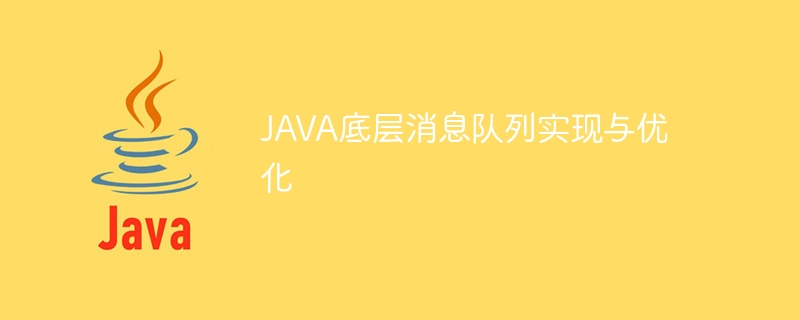

JAVA underlying message queue implementation and optimization
Message queue is a commonly used cross-system and cross-platform asynchronous communication method. It decouples the sender and receiver This improves the scalability and stability of the system. In JAVA development, there are a variety of message queue implementation frameworks to choose from, such as ActiveMQ, RabbitMQ, Kafka, etc. This article will introduce the implementation principle of JAVA's underlying message queue, and give some optimization suggestions and specific code examples.
1. Implementation principles of JAVA’s underlying message queue
The implementation of JAVA’s underlying message queue needs to solve the following core issues: message storage, message transmission and message consumption.
2. Optimization suggestions for the JAVA underlying message queue
When using the JAVA underlying message queue, you can consider the following points for optimization to improve the performance and reliability of the system.
3. Specific code examples
The following is a sample code that uses ActiveMQ as the underlying message queue of JAVA.
import org.apache.activemq.ActiveMQConnectionFactory;
import javax.jms.*;
public class Sender {
public static void main(String[] args) throws JMSException {
// 创建连接工厂
ConnectionFactory factory = new ActiveMQConnectionFactory("tcp://localhost:61616");
// 创建连接
Connection connection = factory.createConnection();
// 开启连接
connection.start();
// 创建会话
Session session = connection.createSession(false, Session.AUTO_ACKNOWLEDGE);
// 创建队列
Queue queue = session.createQueue("testQueue");
// 创建消息生产者
MessageProducer producer = session.createProducer(queue);
// 创建消息
TextMessage message = session.createTextMessage("Hello, World!");
// 发送消息
producer.send(message);
// 关闭连接
producer.close();
session.close();
connection.close();
}
}import org.apache.activemq.ActiveMQConnectionFactory;
import javax.jms.*;
public class Receiver {
public static void main(String[] args) throws JMSException {
// 创建连接工厂
ConnectionFactory factory = new ActiveMQConnectionFactory("tcp://localhost:61616");
// 创建连接
Connection connection = factory.createConnection();
// 开启连接
connection.start();
// 创建会话
Session session = connection.createSession(false, Session.AUTO_ACKNOWLEDGE);
// 创建队列
Queue queue = session.createQueue("testQueue");
// 创建消息消费者
MessageConsumer consumer = session.createConsumer(queue);
// 接收消息
consumer.setMessageListener(new MessageListener() {
@Override
public void onMessage(Message message) {
if (message instanceof TextMessage) {
try {
System.out.println("Received message: " + ((TextMessage) message).getText());
} catch (JMSException e) {
e.printStackTrace();
}
}
}
});
// 保持程序运行
while (true) {
}
}
}The above code example shows how to use ActiveMQ As the underlying message queue of JAVA, messages are sent and received. Developers can configure and optimize accordingly according to actual needs.
Summary:
This article introduces the implementation principle of JAVA's underlying message queue, and gives some optimization suggestions and specific code examples. Through reasonable configuration and optimization, the performance and reliability of the system can be improved and efficient message communication can be achieved. When developers use JAVA's underlying message queue, they should choose an appropriate message queue framework based on actual needs, and make corresponding optimizations based on the actual situation.
The above is the detailed content of JAVA underlying message queue implementation and optimization. For more information, please follow other related articles on the PHP Chinese website!
 what is optimization
what is optimization
 Baidu keyword optimization software
Baidu keyword optimization software
 Baidu SEO keyword ranking optimization method
Baidu SEO keyword ranking optimization method
 What to do if postscript cannot be parsed
What to do if postscript cannot be parsed
 Introduction to win11 screenshot shortcut keys
Introduction to win11 screenshot shortcut keys
 What to do if Linux prompts No such file or directory when executing a file
What to do if Linux prompts No such file or directory when executing a file
 What to do if there is no cursor when clicking on the input box
What to do if there is no cursor when clicking on the input box
 How to use excel macros
How to use excel macros




